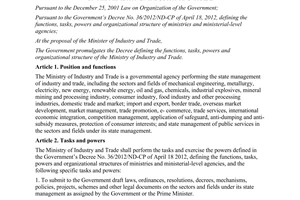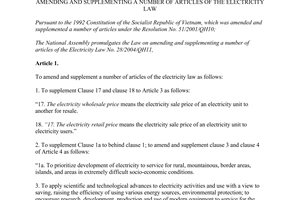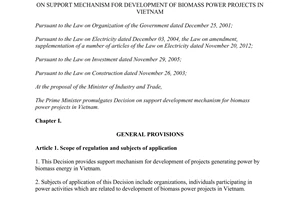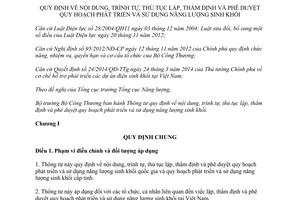Nội dung toàn văn Circular No. 29/2015/TT-BCT plans for development and use of biomass energy
|
MINISTRY OF
INDUSTRY AND TRADE |
SOCIALIST
REPUBLIC OF VIETNAM |
|
No. 29/2015/TT-BCT |
Hanoi, August 31, 2015 |
CIRCULAR
CONTENTS, PROCEDURES FOR DEVELOPING AND APPROVING MASTER PLANS FOR DEVELOPMENT AND USE OF BIOMASS ENERGY
Pursuant to the Law on Electricity No. 28/2004/QH11 dated December 03, 2004 and the Law on amendments to the Law on Electricity dated November 20, 2012;
Pursuant to the Government's Decree No. 95/2012/ND-CP dated November 12, 2012, defining the functions, tasks, powers and organizational structure of the Ministry of Industry and Trade;;
Pursuant to the Prime Minister’s Decision No. 24/2014/QD-TTg dated March 24, 2014 on support for development of biomass electricity projects in Vietnam;
At the request of Director of Energy Administration of Vietnam,
The Minister of Industry and Trade promulgates a Circular on contents, procedures for developing and approving master plans for development and use of biomass energy.
Chapter I
GENERAL PROVISIONS
Article 1. Scope and regulated entities
1. This Circular deals with contents, procedures for developing and approving national and provincial master plans for development and use of biomass energy.
2. This Circular applies to organizations and individuals (hereinafter referred to as entities) involved in development of and approval for master plans for development and use of biomass energy.
Article 2. Interpretation of terms
In this Circular, the terms below are construed as follows:
1. Biomass energy used for electricity generation includes by-products and refuses from agriculture, processing of agriculture products, forestry products, and other plants that can be used as fuel for electricity generation.
2. Theoretical biomass energy potential is the potential biomass energy that can be generated and used sustainably under physical properties of biomass, without regard to restrictions to collection methods. Theoretical biomass energy potential of a form of biomass is estimated according to the ratio of refuses or sustainable production factor and production of certain types of plants.
3. Technical biomass energy potential is the potential biomass energy that can be generated and used from the theoretical biomass energy potential with account taken of restrictions to collection methods. Technical biomass energy potential of a form of biomass is calculated according to the factor of collection of that form of biomass and theoretical energy potential. The collection factor of each type of biomass depends of its characteristics.
4. Commercial biomass energy potential is the technical biomass energy potential that can be used for commercial purposes.
5. National master plan for use of biomass energy (hereinafter referred to as national master plan) is the master plan for determination of total potential for development and use of biomass energy nationwide, distribution of potential among regions and provinces in each period by 2020 with an orientation towards 2030.
6. Provincial master plan for use of biomass energy (hereinafter referred to as provincial master plan) is the master plan for determination of total potential for development and use of biomass energy within a province, distribution of potential among areas within the province in each period by 2020 with an orientation towards 2030.
Chapter II
CONTENTS, PROCEDURES FOR DEVELOPING AND APPROVING MASTER PLANS FOR DEVELOPMENT AND USE OF BIOMASS ENERGY
Article 3. Contents of national master plan for development and use of biomass energy
1. Primary contents of the national master plan for development and use of biomass energy:
a) An overview of development of biomass in the world and Vietnam: generation, supply, and use, applied technologies, support policies and measures; reality of biomass energy development in Vietnam and researches into biomass energy potential in Vietnam;
b) Natural, socio-economic conditions of Vietnam: reality and orientation for development;
c) Current conditions and planning for development of electricity sources and electrical grid of Vietnam;
d) Determination of theoretical, technical, and commercial biomass energy potential; ability to generate biomass energy of Vietnam according to development scenarios;
dd) List of regions and provinces having theoretical, technical, and commercial biomass energy potential;
e) Plans for connection to the national electricity system;
g) Technical, economic, and financial criteria for development of biomass electricity;
h) Strategic assessment of environmental impact of development of biomass electricity projects;
i) Solutions and policies;
k) Conclusions and proposals.
2. Specific contents of the national master plan for development and use of biomass energy is provided for in Appendix I enclosed herewith.
Article 4. Procedures for developing and submitting national master plan for development and use of biomass energy
1. Make a detailed outline and select advisory organization
a) Based on the funding provided by state budget for making national master plan for development and use of biomass energy, Electricity Administration shall make a detailed outline, cost estimate, and plan for development of the national master plan, then submit them to the Minister of Industry and Trade for approval;
b) Electricity Administration shall appoint a capable advisory organization to formulate the national master plan according to the approved outline and cost estimate, then submit the national master plan to the Minister of Industry and Trade for approval;
2. Make and submit the master plan for development and use of biomass energy
The advisory organization appointed to formulate the national master plan has the responsibility to:
a) Formulate the national master plan in accordance with the approved outline and set deadline;
b) Make intermediate reports to seek opinions from relevant agencies and complete the national master plan;
c) Submit an application for approval for the national master plan to Electricity Administration.
3. The application for approval for the master plan for development and use of biomass energy consists of:
a) 15 sets of national master plan and 01 CD/DVD/memory stick that contains the national master plan report and enclosed documents (sufficient biomass figures used for formulating the national master plan and relevant documents);
b) 15 copies of the summary of the national master plan.
Article 5. Appraisal, approval, and announcement of national master plan for development and use of biomass energy
1. Appraisal and submission of national master plan for development and use of biomass energy
a) Electricity Administration is in charge of appraisal of the national master plan which takes place within 30 working days from the receipt of the satisfactory application. If necessary, Electricity Administration may hire consultants and critics to assists the appraisal.
b) Within 05 working days from the receipt of the satisfactory application, Electricity Administration shall send requests for comments about the national master plan to relevant agencies and local governments;
c) The agencies and local governments shall send written responses to Electricity Administration within 15 working days from the receipt of the aforementioned request;
d) After receiving responses from relevant agencies, Electricity Administration shall complete the report on appraisal of the national master plan and submit it to the Minister of Industry and Trade; the Minister of Industry and Trade shall examine the report and submit it to the Prime Minister for decision.
2. Documents to be submitted to the Prime Minister
a) A written request for approval for the master plan;
b) The draft decision on approval for the master plan;
c) 10 sets of the complete national master plan;
d) 10 copies of the summary of the national master plan;
dd) Comments of relevant agencies and local governments;
e) Responses to comments of relevant agencies and local governments.
3. Electricity Administration has the responsibility to announce the approved national master plan for development and use of biomass energy on its website; the Ministry of Industry and Trade shall hold a convention to announce the master plan.
4. The funding for approval and announcement of the master plan for development and use of biomass energy shall comply with effective regulations of law.
Chapter III
CONTENTS, PROCEDURES FOR DEVELOPING AND APPROVING PROVINCIAL MASTER PLANS FOR DEVELOPMENT AND USE OF BIOMASS ENERGY
Article 6. Contents of national master plan for development and use of biomass energy
1. Contents of a provincial master plan for development and use of biomass energy (hereinafter referred to as provincial master plan):
a) Overview of development of biomass energy of the province;
b) Natural, socio-economic conditions of the province and orientation for development;
c) Current conditions and orientation for development of electricity sources and electrical grid in the province;
d) Determination of theoretical, technical, and commercial biomass energy potential; ability to generate biomass energy of the province; plan for generating and using energy according to development scenarios;
dd) List of biomass electricity projects: areas and boundaries of the areas dedicated to biomass electricity development; output of biomass electricity projects.
e) Plans for connection to the national electricity system;
g) The need for capital and financial efficiency of the projects;
h) Strategic environmental impact assessment in construction of biomass electricity projects;
i) Solutions and policies;
k) Conclusions and proposals.
2. Specific contents of provincial national master plans for development and use of biomass energy is provided for in Appendix II enclosed herewith.
Article 7. Procedures for developing and submitting provincial master plan for development and use of biomass energy
1. Make a detailed outline and select consultants
a) According to the funding plan, the Department of Industry and Trade of the province shall make a detailed outline and cost estimate (an advisory organization may be hired) and submit them to the People’s Committee of the province for approval;
b) The Department of Industry and Trade of the province shall appoint a capable advisory organization to formulate the master plan according to the approved outline and cost estimate, then submit it to the People’s Committee of the province for approval.
2. Formulating and submitting provincial master plan for development and use of biomass energy
a) The appointed advisory organization shall formulate the provincial master plan in accordance with the approved outline and set deadline;
b) During the formulation of the provincial master plan, the advisory organization must make intermediate reports to seek opinions from relevant agencies and complete the national master plan;
c) The Department of Industry and Trade of the province shall consult with relevant agencies, electricity company of the province, and Power Corporation of the region that are related to the provincial master plan.
The agencies shall send written responses within 15 working days;
3. An application for approval for the provincial master plan for development and use of biomass energy to be submitted to the Ministry of Industry and Trade consists of:
a) A written request for approval for the master plan made by the People’s Committee of the province;
b) 10 sets of the complete provincial master plan and 01 CD/memory stick that contains the provincial master plan report and enclosed documents (descriptions, appendices, data, figures, comments of relevant agencies, and other reference documents);
c) 10 copies of the summary of the provincial master plan;
d) Comments of relevant agencies;
dd) Responses to comments of relevant agencies.
Article 8. Appraisal, approval, and announcement of provincial master plan for development and use of biomass energy
1. Appraising and approving provincial master plan for development and use of biomass energy
a) Electricity Administration is in charge of appraisal of the provincial master plan which takes place within 30 working days from the receipt of the satisfactory application. If necessary, Electricity Administration may hire consultants and critics to assists the appraisal.
b) Within 05 working days from the receipt of the satisfactory application, Electricity Administration shall send requests for comments about the provincial master plan to relevant agencies and local governments;
c) The agencies and local governments shall send written responses to Electricity Administration within 15 working days from the receipt of the aforementioned request;
d) After receiving responses from relevant agencies, Electricity Administration shall complete the appraisal report and submit it to the Minister of Industry and Trade for approval.
2. The People’s Committee of the province has the responsibility to announce the approved provincial master plan for development and use of biomass energy on its website and hold a convention to announce the master plan.
3. The funding for approval and announcement of the provincial master plan for development and use of biomass energy shall comply with effective regulations of law.
Chapter IV
IMPLEMENTATION
Article 9. Responsibilities of relevant agencies
1. Responsibility of Electricity Administration:
a) Provide consultancy on revisions to master plan for development and use of biomass energy for the Minister of Industry and Trade to suit the current socio-economic conditions;
b) Disseminate, provide guidance, and inspect the implementation of this Circular.
2. Responsibility of the People’s Committees of provinces:
a) Cooperate with the Ministry of Industry and Trade in evaluating local biomass energy potential while formulating the master plan for development and use of biomass energy;
b) Decide the formulation of provincial master plans for development and use of biomass energy according to the biomass energy potential of their provinces or use the figures and information about master plan for development and use of biomass energy for provincial biomass energy development;
c) Request the Ministry of Industry and Trade to decide revisions to provincial master plans for development and use of biomass energy according to current socio-economic conditions of their provinces;
d) Monitor and inspect the progress of local biomass electricity projects according to approved provincial master plans for development and use of biomass energy.
Article 10. Transition clauses
1. The master plans whose outlines, objectives, and cost estimates have been approved by competent authorities before the effective date of this Circular and certified by the Ministry of Industry and Trade shall be implemented as is.
2. Within 90 days from the effective date of this Circular, the provinces having the master plans prescribed in Clause 1 of this Article shall submit them to the Ministry of Industry and Trade for consideration and certification.
Article 11. Effects
1. This Circular comes into force from October 16, 2015.
2. Electricity Administration and relevant agencies shall report difficulties that arise during the implementation of this Circular to the Ministry of Industry and Trade for consideration./.
|
|
PP MINISTER |
APPENDIX I
CONTENTS OF THE NATIONAL MASTER PLAN FOR
DEVELOPMENT AND USE OF BIOMASS ENERGY
(Promulgated together with Circular No. 29/2015/TT-BCT dated August 31, 2015
of the Minister of Industry and Trade)
A. Description
Chapter 1. Overview of development of biomass energy of the world and in Vietnam
1.1. Reality of generation, supply and use of biomass energy
1.2. Technologies and tendency of biomass energy development
1.3. Regional and national policies on biomass energy development
1.4. Reality of biomass electricity development in Vietnam and researches into biomass electricity potential in Vietnam
1.5. Master plan formulation method
1.6. Current policies on support for biomass energy development
Chapter 2. Natural and socio-economic characteristics of Vietnam
2.1. Natural characteristics
2.1.1. Geographical location
2.1.2. Topography
2.1.3. Meteorology
2.2. Socio-economic characteristics
2.2.1. Socio-economic reality
2.2.2. Socio-economic development orientation
2.3. Reality and planning for land use
Chapter 3. Reality and orientation for development of Vietnam’s electricity sources and electrical grid
3.1. Current conditions of the national grid and electricity sources
3.2. Reality of electricity consumption
3.3. Ratio of biomass electricity sources
3.4. National load demand
3.5. Orientation for development of the national grid, electricity sources, and current obstacles to development of biomass electricity
Chapter 4. Determination of theoretical, technical, and commercial biomass energy potential
4.1. Input data
4.2. Method for collecting and processing data
4.3. Primary results
4.4. Characteristics of biomass
4.5. Criteria for determination of theoretical, technical, and commercial biomass energy potential
4.6. List of theoretical, technical, and commercial biomass energy potential
Chapter 5. Plan for connection to the national electricity system.
Chapter 6. Technical, economic, and financial criteria for development of biomass electricity
6.1. Determination of biomass electricity indicators
6.2. Determination of economic and financial indicators of biomass electricity projects
6.3. Estimation of total investment in different stages
Chapter 7. Strategic assessment of environmental impact of biomass electricity activities
7.1. Assessment of land use impacts
7.2. Relocation
7.3. Assessment of environmental impact and potential for reduction of exhaust gas
7.4. Conclusion
Chapter 8. Solutions and policies
8.1. Solutions in terms of capital and formalities
8.2. Polices on support for development of biomass electricity
8.3. Implementation
Chapter 9. Conclusions and proposals
B. Appendices, drawings, and maps
APPENDIX II
CONTENTS OF PROVINCIAL MASTER PLAN FOR DEVELOPMENT
AND USE OF BIOMASS ENERGY
(Promulgated together with Circular No. 29/2015/TT-BCT dated August 31, 2015 of
the Minister of Industry and Trade)
A. Description
Chapter 1. Overview of development of biomass energy of the province
1.1. Technologies and tendency of biomass energy development
1.2. Applicable polices on support for development of biomass electricity
1.3. Reality of generation and development of biomass energy in the province
1.4. Master plan formulation method
1.5. Polices on support for development of biomass electricity
Chapter 2. Natural and socio-economic characteristics of the province
2.1. Natural characteristics
2.1.1. Geographical location
2.1.2. Topography
2.1.3. Rivers
2.1.4. Meteorology
2.2. Socio-economic characteristics
2.2.1. Socio-economic reality
2.2.2. Socio-economic development orientation
2.3. Reality and plan for land use
Chapter 3. Reality and orientation for development of electricity sources and electrical grid in the province
3.1. Current conditions of the provincial grid and electricity sources
3.2. Provincial load demand
3.3. Plan for development of electricity sources in the province
Chapter 4. Determination of theoretical, technical, and commercial biomass energy potential
4.1. Input data
4.2. Method for processing data
4.3. Primary results
4.4. Characteristics of biomass
4.5. Criteria for determination of theoretical, technical, and commercial biomass energy potential
4.6. List of theoretical, technical, and commercial biomass energy potential: areas and boundaries of the areas dedicated to biomass electricity development; output of biomass electricity projects
Chapter 5. Plan for connection to the national electricity system.
Chapter 6. Technical, economic, and financial criteria for development of biomass electricity
6.1. Determination of biomass electricity indicators
6.2. Determination of economic and financial indicators of biomass electricity projects
6.3. Estimation of total investment and different stages
Chapter 7. Strategic assessment of environmental impact of biomass electricity generation
7.1. Assessment of land use impacts
7.2. Relocation
7.3. Assessment of environmental impact and potential for reduction of exhaust gas
7.4. Conclusion
Chapter 8. Solutions and policies
8.1. Solutions in terms of capital and formalities
8.2. Polices on support for development of biomass electricity
8.3. Implementation
Chapter 9. Conclusions and proposals
B. Appendices, drawings, and maps
------------------------------------------------------------------------------------------------------
This translation is made by LawSoft and
for reference purposes only. Its copyright is owned by LawSoft
and protected under Clause 2, Article 14 of the Law on Intellectual Property.Your comments are always welcomed




